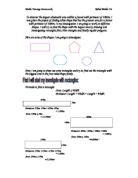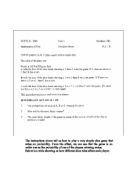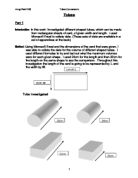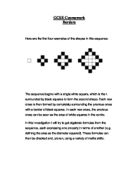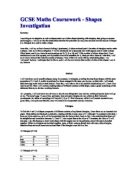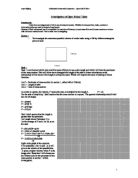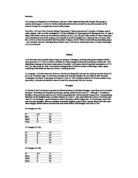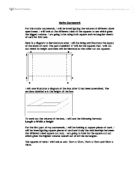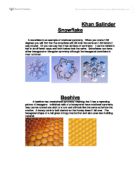Grassland Investigation-Does Light Affect The Distribution Of Daisies?
Grassland Investigation-Does Light Affect The Distribution Of Daisies? Planning Many different factors affect the distribution of plants, and many factors affect the population of animals in different areas. Physical factors and Biotic factors affect these. They can vary from differences in soil fertility, oxygen levels, pressure, temperature, disease, availability of food, colonization and migration. All these affect the level of plants and animals found in one particular area. In this test I am going to see if the level of sunlight affects the distribution of daisies and other plants found in that area. To do this I have found two almost identical areas of grassland within the boundaries of the school. One of these areas has an overhang from the trees next to it, meaning the grass is almost constantly shaded. The other area is very open and has all the advantages and disadvantages of open grassland. I have chosen these 2 areas because they are both flat, although certain parts of the area must not be included as they are sloped. I cannot make this experiment very accurate, as other factors will affect the distribution of daisies other than light, these factors I cannot control. Factors such as rainwater, human activity on the grassland, etc are not possible to control. These factors I must take into account when I write my conclusion. To collect my results I
Fencing - maths coursework
To discover the largest obtainable area within a fenced with perimeter of 1000m, I was given the project of finding what shape that has the greatest area for a farmer with perimeter of 1000m. In my investigation I am going to work on different shapes. I will try to find the shape with the largest area by drawing and investigating rectangles first, then triangles and finally regular polygons. Here are some of the shapes I am going to investigate: Now I am going to draw out some rectangles and try to find out the rectangle with the biggest area in the four sided shape family. Formula to find a rectangle: Area: Length x Width Perimeter: Length + Width + Length + Width 450m 50m Perimeter: 450m +50m + 450m +50m = 1,000m Area: 450m x 50m = 22,500m² 400m 100m Perimeter: 400m +100m + 400m +100m = 1,000m Area: 400m x 100m 350m =40,000m² 150m Perimeter: 350m +150m + 350m +150m = 1,000m Area: 350m x 150m =52,500m² 300m 200m Perimeter: 300m +200m + 300m +200m = 1,000m Area: 300m x 200m 250m = 60,000m² 250m Perimeter: 250m +250m + 250m +250m = 1,000m Area: 250m x 250m = 62,500m² This shows that out of the rectangle family the Square has the furthermost area. ` Area: =250m x 250m = 62,500m²
Dice Maths Investigation
The instructions above tell us how to play a very simple dice game that relies on probability. From the offset, we can see that the game is an unfair one as the probability of one of the players winning varies. Below is a table showing us how different dice roles affect each player. Dice Number 2 3 4 5 6 A Wins B Wins C Wins We can see that the distribution of numbers is not even. However, the probability of each player winning is conditional because if A throws a one, the game finishes and B does not get a chance to throw. To illustrate this more clearly I have created a conditional probability tree diagram: From this simple diagram, the following results are easily obtainable: st Round 2nd Round 3rd Round 4th Round A 1/6 5/108 25/1944 25/34992 B 5/18 25/324 25/5832 625/104976 C 5/18 25/324 25/5832 625/104976 The most important thing I found that each probability had in common with one another, except Player A's first term, was that all the numbers on top were divisible by five and that all the bottom numbers were divisible by 18: 25/5 = 5...324/18 = 18...625/5 = 125...104976/18 = 5832. You will notice that when any of the probabilities are divided by 5/18 the result is the previous probability. This is because the probability of a player winning is multiplied by the probability of all the previous rounds passing. Seeing as the
In this work I investigated different shaped tubes, which can be made from rectangular sheets of card, of given width and length. I used Microsoft Excel to collate data.
Tubes Part 1 Introduction: In this work I investigated different shaped tubes, which can be made from rectangular sheets of card, of given width and length. I used Microsoft Excel to collate data. (These sets of data are available in a set of appendixes at the back) Method: Using Microsoft Excel and the dimensions of the card that were given, I was able to collate the data for the volume of different shaped tubes. I used different formulas to try and test out what the maximum volumes were for each given shape. I used 24cm for the length and then 32cm for the length on the same shape to see the comparison. Throughout this investigation the length of the card is going to be represented by L and the width by W. Tube investigated To find the volumes of the different shaped tubes, I worked out the cross sectional area and then multiplied that by the length of the tube. General Formulas for volumes of prisms Cylinder: cross sectional area = ?r2 Volume = ?r2 x length Cuboid with rectangular end face: cross sectional area = width x length Volume = cross sectional area x length of prism Equilateral and Isosceles Triangle face: cross sectional area = 0.5 x base x height Volume = cross sectional area x length of prism Hexagon: cross sectional area = Generalised Formula for working out the volume of any polygon Results: Refer to appendix 1 for the data collected for
Borders - Fencing problem.
GCSE Coursework Borders Here are the first four examples of the shapes in this sequence: The sequence begins with a single white square, which is then surrounded by black squares to form the second shape. Each new cross is then formed by completely surrounding the previous cross with a border of black squares. In each new cross, the previous cross can be seen as the area of white squares in the centre. In this investigation I will try to get algebraic formulas from the sequence, each expressing one property in terms of another (e.g. defining the area as the diameter squared). These formulas can then be checked and, proven, using a variety of maths skills. Defining N The variable that I will be using to refer to terms in this investigation will be n. As there could be confusion over this matter I thought that it is important to state that the first term in the sequence which is just one white cross will have a value of n which is equal to zero. This means the n'th term for any shape in the sequence will be the number of squares that extend from the centre square out to the edge. e.g.) After looking at this diagram I worked out that the width of this shape would be: 2n + 1. This also works for all of the other shapes in the sequence here is a table to prove it. n 2n + 1 width (counted) 0 3 3 2 5 5 3 7 7 4 9 9 5 1 1 Perimeter If I count the number of
Shapes Investigation I will try to find the relationship between the perimeter (in cm), dots enclosed and the amount of shapes (i.e. triangles etc.) used to make a shape.
GCSE Maths Coursework - Shapes Investigation Summary I am doing an investigation to look at shapes made up of other shapes (starting with triangles, then going on squares and hexagons. I will try to find the relationship between the perimeter (in cm), dots enclosed and the amount of shapes (i.e. triangles etc.) used to make a shape. From this, I will try to find a formula linking P (perimeter), D (dots enclosed) and T (number of triangles used to make a shape). Later on in this investigation T will be substituted for Q (squares) and H (hexagons) used to make a shape. Other letters used in my formulas and equations are X (T, Q or H), and Y (the number of sides a shape has). I have decided not to use S for squares, as it is possible it could be mistaken for 5, when put into a formula. After this, I will try to find a formula that links the number of shapes, P and D that will work with any tessellating shape - my 'universal' formula. I anticipate that for this to work I will have to include that number of sides of the shapes I use in my formula. Method I will first draw out all possible shapes using, for example, 16 triangles, avoiding drawing those shapes with the same properties of T, P and D, as this is pointless (i.e. those arranged in the same way but say, on their side. I will attach these drawings to the front of each section. From this, I will make a list of all
Find a formula to enable the perimeter to be found for any odd Pythagorean triple.
Perimeter: I want to find a formula to enable me to find the perimeter for any odd Pythagorean triple. I know that perimeter is a + b + c so I know the formula for the shortest, middle and longest side so I can assume that if I substitute the formulas I know, I can presume I will find the formulas for the perimeter. The perimeter = a + b + c. Therefore I took my formula for 'a' (2n + 1), my formula for 'b' (2n² + 2n) and my formula for 'c' (2n² + 2n + 1). I then did the following: a + b + c (2n + 1) + (2n² + 2n) + (2n² + 2n + 1) = 2n + 1 + 2n + 2n + 1 + 4n² = 4n² + 6n + 1 + 1 = 4n² + 6n + 2 = formula for perimeter I will further prove this formula by using sequences. 3,4,5 5,12,13 7,24,25 9,40,41 11,60,61 12 30 56 90 132 +18 +26 +34 +42 +8 +8 +8 Here the first differences aren't the same, but the second differences are. If the second difference is a constant, then the formula for the nth term contains n². The number in front of n² is half the constant difference. Therefore the first part of the formula is 4n². Here I will substitute 4n² into a table to find the rest of the formula. The difference is the difference between perimeter and the 4n²: Term number: 1 2 3
Investigation of Open Ended Tubes.
Investigation of Open Ended Tubes Introduction. Tubes form an integral part of life in any developed country. Whether to transport fuel, water, coolant or information tubes are used in almost all appliances. Because of their widespread use it is important to maximise efficiency; in most cases this would mean maximum volume with minimum material used. That is what I am investigating. Section 1 - To investigate the maximum possible volume of a tube made using a 320 by 240mm rectangular piece of card. Task 1 Task 1 is to discover which side would be most efficient to use as the length and which will form the perimeter of the cross-section. This will allow me to disregard the length of the tube in future calculations as the relationship will be linear if the length is always the same. Which will improve the ease of reading of future formulae. Let P = Perimeter of cross-section (in section 1, either 240 or 320mm) Let L = Length of tube Let A = Area of cross-section As a tube is a prism, the volume, V equals the area A multiplied by the length L. V = AL For the sake of simplicity, I shall assume that the cross-section is a square. The general relationship should hold true for all shapes. V = (P/4)²L V = (P/4) ²L V = (P²/16)L V = P²L/16 Next I shall assume that the length is greater than the perimeter. Let Length minus Perimeter =2 x Let the average of P and
Am doing an investigation to look at shapes made up of other shapes (starting with triangles, then going on squares and hexagons. I will try to find the relationship between the perimeter (in cm), dots
Summary I am doing an investigation to look at shapes made up of other shapes (starting with triangles, then going on squares and hexagons. I will try to find the relationship between the perimeter (in cm), dots enclosed and the amount of shapes (i.e. triangles etc.) used to make a shape. From this, I will try to find a formula linking P (perimeter), D (dots enclosed) and T (number of triangles used to make a shape). Later on in this investigation T will be substituted for Q (squares) and H (hexagons) used to make a shape. Other letters used in my formulas and equations are X (T, Q or H), and Y (the number of sides a shape has). I have decided not to use S for squares, as it is possible it could be mistaken for 5, when put into a formula. After this, I will try to find a formula that links the number of shapes, P and D that will work with any tessellating shape - my 'universal' formula. I anticipate that for this to work I will have to include that number of sides of the shapes I use in my formula. Method I will first draw out all possible shapes using, for example, 16 triangles, avoiding drawing those shapes with the same properties of T, P and D, as this is pointless (i.e. those arranged in the same way but say, on their side. I will attach these drawings to the front of each section. From this, I will make a list of all possible combinations of P, D and T (or later Q
Probability is the Likelihood, or chance, that an event will occur, often expressed as odds, or in mathematics, numerically as a fraction or decimal.
Probability Probability is the Likelihood, or chance, that an event will occur, often expressed as odds, or in mathematics, numerically as a fraction or decimal. In general, the probability that n particular events will happen out of a total of m possible events is n/m. A certainty has a probability of 1; an impossibility has a probability of 0. Empirical probability is defined as the number of successful events divided by the total possible number of events. In tossing a coin, the chance that it will land `heads´ is the same as the chance that it will land `tails´, that is, 1 to 1 or even; mathematically, this probability is expressed as 1/2 or 0.5. The odds against any chosen number coming up on the roll of a fair die are 5 to 1; the probability is 1/6 or 0.1666... . If two dice are rolled there are 6 ´ 6 = 36 different possible combinations. The probability of a double (two numbers the same) is 6/36 or 1/6 since there are six doubles in the 36 events: (1,1), (2,2), (3,3), (4,4), (5,5), and (6,6). Independent events are those which do not affect each other, for example rolling two dice are independent events, as the rolling of the first die does not effect the outcome of the rolling of the second die. If events are described as mutually exclusive it means that if one happens, then it prevents the other from happening. So tossing a coin is



